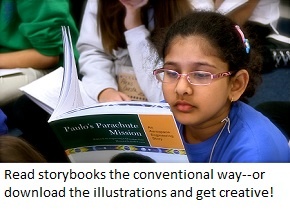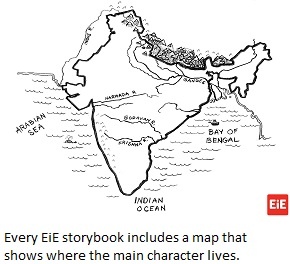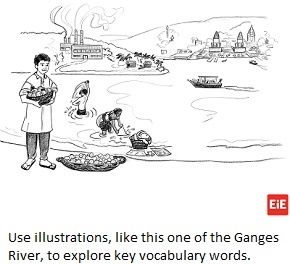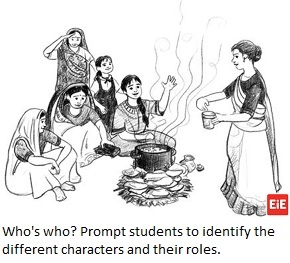Every Thursday on the blog we bring you teaching tips or news about resources you can use in your classroom
 Every Engineering is Elementary (EiE) unit starts with a storybook that sets the context for the hands-on engineering design challenge. You can show the pictures to your students the conventional way, by holding up the book for everyone to see . . . but you can also download storybook illustrations from our website and project them on a screen or SmartBoard. Beyond the convenience of this approach, storybook illustrations are a terrific teaching tool for English Language Arts, and especially for the English Language Learners in your class.
Every Engineering is Elementary (EiE) unit starts with a storybook that sets the context for the hands-on engineering design challenge. You can show the pictures to your students the conventional way, by holding up the book for everyone to see . . . but you can also download storybook illustrations from our website and project them on a screen or SmartBoard. Beyond the convenience of this approach, storybook illustrations are a terrific teaching tool for English Language Arts, and especially for the English Language Learners in your class.
Using Storybook Illustrations: The Big Picture
 Stories appeal to all kids, regardless of cultural background, interests, or learning style. Instead of reading a storybook word for word, project the illustrations while you retell the story at a language level that’s appropriate for your students.
Stories appeal to all kids, regardless of cultural background, interests, or learning style. Instead of reading a storybook word for word, project the illustrations while you retell the story at a language level that’s appropriate for your students.
The illustrations includes everything you need to tell the story: key settings, key characters, and the actions these characters take as the story unfolds.
Our storybooks are set in locations around the world, so each collection of illustrations also includes a map that gets students oriented. And look for the special multi-image illustrations that tell a story-within-the-story, such as "how a food web works" in Tehya’s Pollution Solution, or the steps it takes to collect firewood for cooking a meal in Lerato Cooks Up a Plan.
Top Tips for ELA Instruction with EiE Illustrations
 Vocabulary Development: Use the illustrations to explore key vocabulary words in the story. For example, as you show the illustration from page 15 of Saving Salila’s Turtle (right), ask, “Why do you think the river is getting polluted?” Point to the illustrations, use gestures, define words in terms students can understand, and encourage them to repeat the words aloud.
Vocabulary Development: Use the illustrations to explore key vocabulary words in the story. For example, as you show the illustration from page 15 of Saving Salila’s Turtle (right), ask, “Why do you think the river is getting polluted?” Point to the illustrations, use gestures, define words in terms students can understand, and encourage them to repeat the words aloud. - Understanding Plot and Sequence: Students can use the illustrations as prompts to tell the story on their own: What happened first? What happened next? This could also be a writing activity, where you ask students to put between three and five illustrations in order and write a sentence about what’s happening in each illustration.
 Who’s Who: Prompt students to identify the characters in the illustrations. Which one is telling the story? How are the other characters related to this main character? What is each character’s role in the story? Turn it into a writing activity, where kids draw a cartoon that tells the story from a different character’s viewpoint.
Who’s Who: Prompt students to identify the characters in the illustrations. Which one is telling the story? How are the other characters related to this main character? What is each character’s role in the story? Turn it into a writing activity, where kids draw a cartoon that tells the story from a different character’s viewpoint.- Making Predictions: Show students an illustration and ask, “I wonder what happens next?”
Storybook Illustrations: Where to Find Them
Here are two ways to navigate to the downloadable online storybook illustrations:
From the EiE Resources Page
- Go to the “Curriculum Resources” page
- Use the “Browse Resources by . . .” menu to select “Storybook Illustrations”
- Use the check-box options under “Browse Resources” to select the unit you want
- Click the blue “GO” button
From the Curriculum Unit Landing Page
- Go to the “Curriculum Units” page, where you can browse all 20 curriculum units
- Select the curriculum unit you are teaching
- Scroll down in the unit page to the table labeled “Resources for this Unit”
- Click on “Storybook Illustrations (PDF)”
Note that every Teacher Guide includes one copy of the storybook. Want each student to have their own book? Extra copies (or class sets) are available through the EiE Store.
Do you have an EiE Teacher Tip to share with other educators? Send it in today, and you could be featured on the Thursday blog!
Engineering is Elementary is a project of the National Center for Technological Literacy® at the Museum of Science, Boston.









